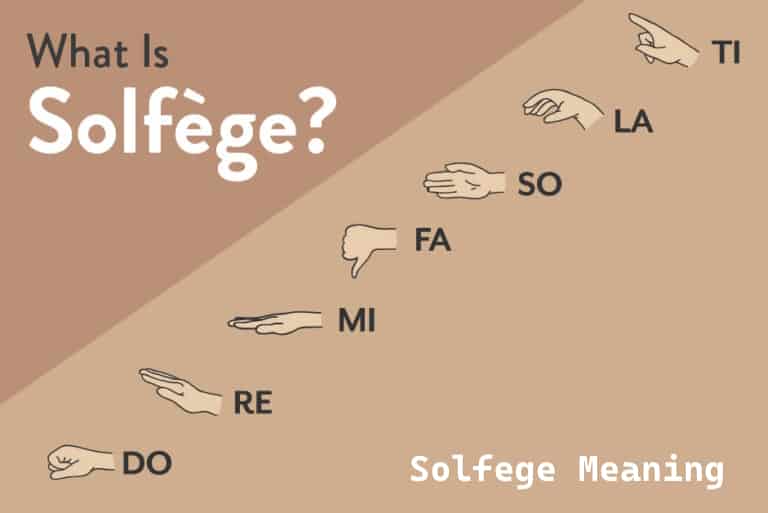Have you ever wondered how musicians can read notes on a page and instantly sing them? The secret lies in a powerful tool called solfege. This musical language has been helping singers and instrumentalists for centuries, and it’s time you got in on the action. Let’s dive into the world of solfege and discover how it can transform your musical journey.
Key Takeaways:
- Solfege is a system of naming musical notes using syllables (Do, Re, Mi, etc.)
- It helps musicians improve pitch recognition and sight-reading skills
- Solfege has two main systems: Movable Do and Fixed Do
- Learning solfege can enhance your overall musical abilities
- Solfege is used in music education, vocal training, and even modern music production
What is Solfege?

Solfege, also spelled solfa or solfège, is a method of naming musical notes using syllables. Instead of using letter names like A, B, C, musicians use syllables like Do, Re, Mi. If you’ve ever seen “The Sound of Music,” you’ve heard solfege in action!
Also read: Waning Gibbous Emoji 🌖
The Origin Story
Solfege has been around for a long time. It dates back to the 11th century when an Italian monk named Guido d’Arezzo came up with the idea. He wanted to help his fellow monks remember the melodies of chants more easily. Talk about a game-changer!
The Solfege Syllables
The heart of solfege lies in its syllables. Here they are in all their glory:
- Do (pronounced “doh”)
- Re (pronounced “ray”)
- Mi (pronounced “mee”)
- Fa (pronounced “fah”)
- Sol (pronounced “sole”)
- La (pronounced “lah”)
- Ti (pronounced “tee”)
These syllables correspond to the seven notes of the major scale. Each has its own unique sound and hand sign, making it easier to recognize and remember.
Types of Solfege Systems
When it comes to solfege, there’s more than one way to sing a scale. The two main systems are:
1. Movable Do
In this system, “Do” always represents the tonic (or home note) of the key you’re in. So if you’re in the key of C, Do is C. But if you switch to the key of G, Do becomes G. It’s like your musical home base moves around.
2. Fixed Do
Here, each syllable is tied to a specific pitch. Do is always C, Re is always D, and so on. This system is more common in countries like France and Italy.
Both systems have their fans, and each has its strengths. Movable Do is great for understanding the relationships between notes in different keys, while Fixed Do helps with absolute pitch recognition.
Also read: HWDP
Benefits of Learning Solfege

Learning solfege isn’t just for fun (although it can be pretty enjoyable). It comes with some serious musical perks:
- Improved pitch recognition: You’ll start to hear the differences between notes more clearly.
- Better sight-reading skills: Reading music becomes more intuitive.
- Enhanced musical memory: Those melodies will stick in your head more easily.
Think of solfege as your musical superpower. It’s like learning to speak the language of music fluently. Once you’ve got it down, you’ll wonder how you ever made music without it!
How Solfege is Used in Music Education
Solfege isn’t just a cool party trick for musicians. It’s a fundamental tool in music education, used in various ways:
Vocal Training
For singers, solfege is like a secret weapon. It helps them:
- Nail those tricky intervals
- Improve their pitch accuracy
- Develop a better understanding of melody structure
I remember when I first started using solfege in my choir practice. It was like a lightbulb went off – suddenly, I could hear the relationships between notes much more clearly!
Also read: IMS Meaning
Instrumental Instruction
Even if you’re not a singer, solfege can seriously up your instrumental game. It’s used to:
- Enhance sight-reading abilities
- Improve understanding of musical phrases
- Boost overall musicianship
Music Theory Classes
In the world of music theory, solfege is a star player. It helps students:
- Understand scale degrees
- Recognize chord progressions
- Analyze musical structures more effectively
Solfege in Popular Culture

Solfege isn’t just confined to stuffy music classrooms. It’s made its way into popular culture in some pretty cool ways:
- The Sound of Music: Who can forget Julie Andrews teaching “Do-Re-Mi” to the von Trapp children? This iconic scene introduced solfege to millions.
- Bobby McFerrin’s Audience Experiment: In a viral video, the famous vocalist demonstrates how deeply ingrained the pentatonic scale (a five-note scale often used in solfege training) is in our musical consciousness.
These examples show how solfege has become part of our shared musical language, even for those who’ve never set foot in a music class.
Tips for Learning Solfege
Ready to dive into the world of solfege? Here are some tips to get you started:
- Start simple: Begin with major scales and simple melodies.
- Use hand signs: Incorporate the Kodály hand signs to reinforce the pitch relationships visually.
- Practice regularly: Even 10 minutes a day can make a big difference.
- Use online resources: Websites like Teoria offer free solfege exercises.
- Join a choir or singing group: Practicing with others can accelerate your learning.
Remember, learning solfege is like learning any new skill – it takes time and patience. But stick with it, and you’ll be amazed at how it transforms your musical abilities!
Also read: HBU
Advanced Solfege Concepts
Once you’ve got the basics down, you can explore some more advanced solfege concepts:
Chromatic Solfege
This involves using additional syllables for the notes between the main scale degrees. For example:
- Di (pronounced “dee”) for the raised Do
- Ri (pronounced “ree”) for the raised Re
Solfege in Complex Musical Pieces
Advanced musicians use solfege to navigate through complex harmonies and modulations. It’s like having a musical GPS!
Solfege in Different Keys
| Key | Do | Re | Mi | Fa | Sol | La | Ti |
|---|---|---|---|---|---|---|---|
| C Major | C | D | E | F | G | A | B |
| G Major | G | A | B | C | D | E | F# |
This table shows how solfege syllables correspond to different notes in various keys, demonstrating the flexibility of the movable Do system.
Solfege in the Digital Age
As with many traditional practices, solfege has found new life in the digital world. Here are some ways technology is making solfege more accessible and fun:
- Mobile Apps: Apps like “Perfect Ear” and “Solfa Learn” offer interactive solfege exercises you can practice anytime, anywhere.
- Online Courses: Platforms like Coursera and Udemy have courses dedicated to solfege training.
- YouTube Tutorials: There’s a wealth of free solfege lessons on YouTube, from beginner to advanced levels.
These digital tools are great for supplementing traditional learning methods. They’re like having a solfege tutor in your pocket!
Solfege and Music Production

Even in the world of modern music production, solfege has its place. Many producers and composers use solfege to:
- Quickly communicate melodic ideas to vocalists
- Develop catchy hooks and melodies
- Analyze and recreate popular songs
It’s like a secret language that helps musicians translate what’s in their head into actual music. Just as FYSA keeps you in the loop with current events, solfege keeps you in tune with musical ideas!
Common Challenges and How to Overcome Them
Learning solfege isn’t always a walk in the park. Here are some common hurdles and how to jump over them:
- Difficulty with intervals: Start with smaller intervals and gradually work your way up. Use familiar songs to help remember how different intervals sound.
- Confusion between Movable Do and Fixed Do: Choose one system and stick with it initially. You can always learn the other later.
- Trouble with sight-singing: Practice regularly, even if it’s just for a few minutes each day. Start with simple melodies and progressively challenge yourself.
- Feeling overwhelmed: Remember, everyone learns at their own pace. It’s not a race! Celebrate small victories and keep pushing forward.
If you’re feeling sus about your progress, don’t worry! Everyone struggles at first. Keep at it, and you’ll improve.
The Global Perspective on Solfege
Interestingly, solfege isn’t used uniformly around the world. Different countries have their own approaches:
- In English-speaking countries, letter names (A, B, C, etc.) are often used alongside solfege.
- In Germany, H is used instead of B, and B is used for B-flat.
- In India, a similar system called Sargam uses the syllables Sa, Re, Ga, Ma, Pa, Dha, Ni.
This global diversity shows how different cultures have adapted the concept of pitch naming to suit their musical traditions. It’s like how slang terms like GYAT or WTW can mean different things in different contexts!
Conclusion: The Power of Solfege
Solfege might seem like just another musical term to learn, but it’s so much more than that. It’s a powerful tool that can transform your musical journey, whether you’re a beginner or an experienced musician.
By learning solfege, you’re not just memorizing syllables – you’re training your ear, improving your sight-reading, and developing a deeper understanding of music theory. It’s like learning to read and speak the language of music fluently.
Remember, like any skill, mastering solfege takes time and practice. But the musical rewards are well worth the effort. So why not give it a try? Start with simple exercises, use the resources available, and before you know it, you’ll be sight-singing like a pro!
Who knows? The next time you hear a catchy tune on the radio, you might find yourself automatically breaking it down into Do, Re, Mi. And that’s when you’ll know – you’re not just listening to music anymore, you’re truly understanding it.
So, are you ready to speak the language of music? Your solfege journey starts now. Do, Re, Mi, Fa, Sol, La, Ti, Do… and off you go!







